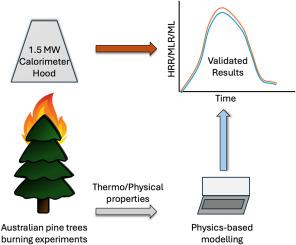Experimental and numerical investigation of burning characteristics of Australian pine trees for wildfire modelling
IF 3.3
3区 工程技术
Q2 ENGINEERING, CIVIL
引用次数: 0
Abstract
Crown fires, which spread rapidly and with high intensity, present a significant challenge in wildfire management, particularly in wildland–urban interface (WUI) areas. A fundamental aspect of understanding crown fire behaviour is the combustion dynamics of individual trees, which serve as building blocks for larger-scale fire spread. This study aims to investigate the burning characteristics of Australian pine trees through both experimental and numerical methods, focusing on heat release rate (HRR), mass loss rate (MLR), total mass loss (ML), and heat flux. Experimental measurements were obtained by burning Australian pine trees under a 1.5 MW calorimeter hood, with key thermal parameters recorded. These results were compared to similar data from other tree species. A fully physics-based model was validated against experimental results. Two approaches for defining the heat of combustion in the physical simulations were explored: one based on reaction properties and the other on material properties. The study found that both approaches could effectively reproduce HRR, MLR, and ML, though discrepancies were noted in heat flux predictions due to assumptions regarding vegetation distribution. Notably, this research represents the first experimental-numerical comparison of HRR data for any tree combustion and provides a valuable contribution to understanding fire dynamics. The findings have important implications for enhancing wildfire prediction models and improving fire safety strategies in the WUI.

澳大利亚松树燃烧特性的实验和数值研究用于野火模拟
林火蔓延迅速,强度高,对森林火灾管理提出了重大挑战,特别是在荒地-城市界面(WUI)地区。了解树冠火灾行为的一个基本方面是单个树木的燃烧动力学,这是大规模火灾蔓延的基础。本研究旨在通过实验和数值方法研究澳大利亚松树的燃烧特性,重点研究热释放率(HRR)、质量损失率(MLR)、总质量损失率(ML)和热通量。实验测量是通过在1.5 MW热量计罩下燃烧澳大利亚松树获得的,并记录了关键的热参数。这些结果与其他树种的类似数据进行了比较。根据实验结果验证了完全基于物理的模型。探讨了物理模拟中燃烧热的两种定义方法:一种基于反应性质,另一种基于材料性质。研究发现,这两种方法都可以有效地再现HRR、MLR和ML,但由于对植被分布的假设,在热通量预测中存在差异。值得注意的是,这项研究首次对任何树木燃烧的HRR数据进行了实验和数值比较,为理解火灾动力学提供了有价值的贡献。研究结果对加强森林火灾预测模型和改善森林火灾安全策略具有重要意义。
本文章由计算机程序翻译,如有差异,请以英文原文为准。
求助全文
约1分钟内获得全文
求助全文
来源期刊

Fire Safety Journal
工程技术-材料科学:综合
CiteScore
5.70
自引率
9.70%
发文量
153
审稿时长
60 days
期刊介绍:
Fire Safety Journal is the leading publication dealing with all aspects of fire safety engineering. Its scope is purposefully wide, as it is deemed important to encourage papers from all sources within this multidisciplinary subject, thus providing a forum for its further development as a distinct engineering discipline. This is an essential step towards gaining a status equal to that enjoyed by the other engineering disciplines.
 求助内容:
求助内容: 应助结果提醒方式:
应助结果提醒方式:


